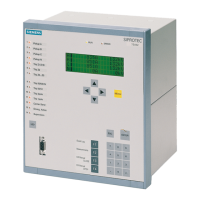•
Operational messages (event log); messages generated while the device is operating: Information
regarding the status of device functions, measured data, power system data, control command logs etc.
•
Fault indications; these are indications of the last 25 network faults that were processed by the device.
•
Ground fault messages (when the device has sensitive ground fault detection).
•
Messages of "statistics"; they include a counter for the trip commands initiated by the device and possibly
reclose commands as well as values of interrupted currents and accumulated fault currents.
A complete list of all message and output functions that can be generated by the device with the maximum
functional scope can be found in the appendix. All functions are associated with an information number
(FNo). There is also an indication of where each message can be sent to. If functions are not present in a not
fully equipped version of the device, or are configured to Disabled, then the associated indications cannot
appear.
Operational Messages (Buffer: Event Log)
The operational messages contain information that the device generates during operation and about opera-
tional conditions. Up to 200 operational messages are recorded in chronological order in the device. New
messages are appended at the end of the list. If the memory is used up, then the oldest message is scrolled
out of the list by a new message.
Fault Messages (Buffer: Trip Log)
After a fault on the system, for example, important information about the progression of the fault can be
retrieved, such as the pickup of a protective element or the initiation of a trip signal. The start of the fault is
time stamped with the absolute time of the internal system clock. The progress of the disturbance is output
with a relative time referred to the instant of fault detection, so that the duration of the fault until tripping and
up to reset of the trip command can be ascertained. The resolution of the time information is 1 ms.
Spontaneous Displays on the Device Front
After occurrence of a fault, the most important fault data is output automatically on the device display,
without any further operating actions. It is displayed after a general device pickup in the sequence shown in
the following figure.
[anzeige-spontanmeld-im-display-20070326, 1, en_US]
Figure 2-122 Display of spontaneous messages in the HMI
Retrievable Messages
The messages for the last eight network faults can be retrieved and read out. The definition of a network fault
is such that the time period from fault detection up to final clearing of the disturbance is considered to be one
network fault. If auto-reclosing occurs, then the network fault ends after the last reclosing shot, which means
after a successful reclosing or lockout. Therefore the entire clearing process, including all reclosing shots,
occupies only one trip log buffer. Within a network fault, several fault messages can occur (from the first
pickup of a protective function to the last dropout of a protective function). Without auto-reclosing each fault
event represents a network fault.
In total 600 indications can be recorded. Oldest data are erased for newest data when the buffer is full.
Ground Fault Messages
In devices with sensitive ground fault detection, separate ground fault logs are provided for ground fault
recording. These logs are completed if the ground fault detection is not set to tripping but to Alarm Only
(address 3101 = Alarm Only) or the setting ON with GF log has been selected. With setting ON with
GF log, there is also a trip, apart from the opening of the ground fault log.
Functions
2.23 Auxiliary Functions
278 SIPROTEC 4, 7SJ80, Manual
E50417-G1140-C343-A8, Edition 12.2017

